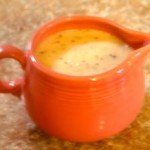A spoonful of sugar makes the panic attacks go away? Well, maybe it will help.
 One of the newest sugars on the alternative sweetener aisle has been around for hundreds of years in southeast Asia. Now it is quickly becoming the favorite here, too. Coconut palm sugar has the advantage of being natural, minimally processed, good for you, and low glycemic. Sound good?
One of the newest sugars on the alternative sweetener aisle has been around for hundreds of years in southeast Asia. Now it is quickly becoming the favorite here, too. Coconut palm sugar has the advantage of being natural, minimally processed, good for you, and low glycemic. Sound good?
The sugar is made from the sap of the coconut palm, grown mainly in the Philippines. The farmers make a slit in at the base of the coconut flower and the sap which would be otherwise flowing into the flower to make a coconut is diverted into a bamboo bucket.
Coconut palm sugar tastes slightly like brown sugar but has twice the iron, four times the magnesium and more than 10 times the amount of zinc. It also contains vitamin B1, B2, B3 and B6. It contains16 amino acids, including Glutamine which has been shown to be useful in the treatment of several illnesses, injury, trauma and burns.
Inositol is another vitamin found abundantly in coconut sap. Among other things, Inositol is known to relieve the symptoms of diabetic neuropathy and is recommended as a treatment for anxiety, depression, bipolar mood disorder, obsessive compulsive disorder and, yes, panic disorders. I’m not sure how much sugar you would need to eat to get enough Inositol to do you much good, but it would certainly be a pleasant treatment!
This sugar has a low glycemic index of 35, is not ridiculously expensive, and has the same number of calories of white table sugar. It substitutes 1:1 in recipes.
So what’s the downside? I found a Web site proclaiming “The Other Side of Coconut Palm Sugar” and thought, “Here’s the bad news.” To my surprise, the bad news was that sugar was becoming so profitable that the farmers were harvesting the sap instead of growing coconuts, which would lead to a shortage of coconut and coconut oil. No adverse effects of the sugar at all.
Tastes good, is low glycemic, and substitutes easily for white sugar. If it had lower calories it would be perfect, but as a healthy alternative, it comes pretty close.
Eating to live and living for Christ,
Susan Jordan Brown

